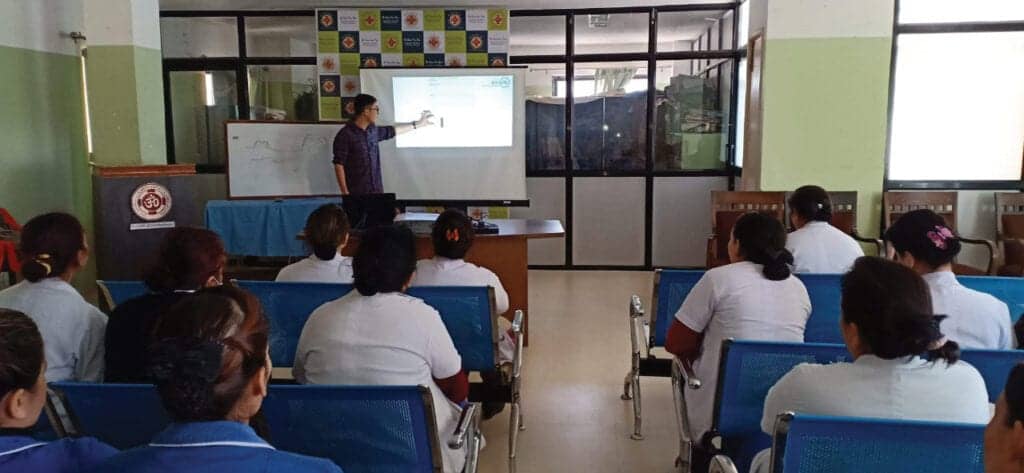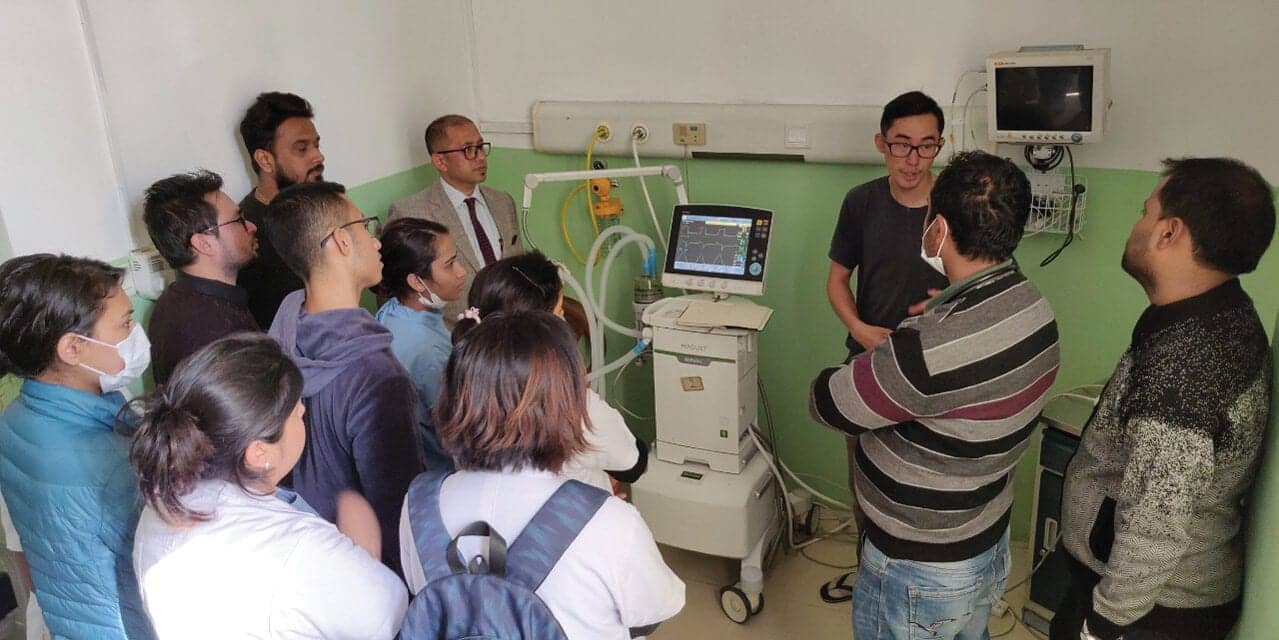Through RTs Without Borders, licensed RTs are deployed across the globe to provide access to high-quality respiratory care for underserved populations. This is the story of its RTs serving overseas, their work, and how the recent COVID-19 pandemic is affecting them and the isolated communities they serve.
By Phyllis Hanlon
Editor’s Note: The majority of this article was researched and written prior to the COVID-19 pandemic. An addendum has been added that includes information on how coronavirus affected RTs Without Borders and its staff.
The 1971 war and famine in Biafra, Nigeria prompted thirteen journalists and doctors to found an organization that would provide medical assistance to those enduring conflict, disasters, epidemics and lack of access to healthcare. The nonprofit, self-governing, member-based Médicins Sans Frontières (MSF/Doctors Without Borders) aimed to provide high-quality medical care and to advocate for affordable first-class medications. This medical, humanitarian organization grew rapidly and can now be found in more than 60 countries.
Inspired by this model, a respiratory therapist from Canada decided to launch a similar group that would address the respiratory needs of the underserved.

Serving the Underserved
In 2007, Eric Cheng, BSc, RRT, traveled to Nepal to learn about the country’s healthcare system. What he found was shocking and devastating—the standard of care was significantly lacking and there existed an educational gap regarding respiratory knowledge, particularly with ventilators and oxygen. This discovery prompted him initially to become a qualified anesthesia assistant. However, he soon learned that these hospitals needed respiratory therapy education more than anesthesia. Three years later, Cheng returned to Nepal with the Canadian charity Bringing About Better Understanding (BABU). During his two-and-a-half month trip, he delivered talks on CPAP therapy for neonates and helped four hospitals set up primitive systems with unused spare parts donated by Canadian hospitals. Cheng received an award for his efforts from the Respiratory Therapy Society of Ontario (RTSO) and some members encouraged him to launch a charitable organization for RTs.
But before he created Respiratory Therapists Without Borders (RTWB), Cheng returned to Nepal and found that the CPAP program he had helped create was no longer in existence due to lack of human resources, reliable electricity and oxygen. The situation clearly indicated a need for respiratory therapists who could “educate, improvise and innovate” under challenging circumstances. Thus, RTWB was born in 2012 with a handful of members and a small board of directors.

Life Changing Experience
Clement Hui, RRT, director of deployment, became involved with RTWB after seeing a call for volunteers on the Internet. He had read about the healthcare needs in Nepal and wanted to help. Since volunteering, he has been to Nepal five times, each time at different sites.
When Hui first visited a hospital in Nepal in 2015, the facility treated an average of 50 patients a day for various respiratory issues, fractures, sepsis, venomous snakebites and organic phosphate overdoses. During that first assignment, he and his fellow RTs implemented policies and procedures and provided training for noninvasive ventilation (NIV) in the emergency room, bubble CPAP for newborns and neonatal resuscitation.
The following year, Hui returned to Nepal and was assigned to Tansen Hospital. He was charged with perfecting a bubble CPAP system for neonates so the hospital could become a launch site for a new biphasic device that developing countries could afford.
The assignment proved to be somewhat daunting as the hospital was seriously understaffed, lacked sufficient equipment and had ineffective infection control practices. Language and cultural barriers further complicated the task. Pediatricians also had very little experience ventilating babies so Hui taught them, along with nursing staff and anesthesiologists, the techniques and also evaluated gaps in current practices. Hui said, “We’re training medical professionals.”
Hui utilizes his hands-on skills when conducting workshops during his volunteer assignments. “What I do depends on the site. In one city, I was engaged in a couple of projects trying to keep up with education. Once you teach a hospital some skills, if you don’t do it annually, they lose the skill set,” he said. “My workshops and topics depend on the hospital’s needs. Usually they involve anything from airway management to NIPPV, ventilation modes, waveform, troubleshooting, oxygen therapy, etcetera.”
In spite of the challenges, Hui found these experiences to be life changing, serving to renew his purpose in life and in his career.
Volunteerism Trial
Early in her career Canadian Nicole Zaldivar, RRT, worked with Cheng and expressed an interest in volunteering abroad. Although she did not undergo the formal application process, she completed what she called a “primer” before making a long-term commitment.
During a short-term trip, Zaldivar spent four days in Kathmandu, visiting different hospitals to learn about their workflow and how they care for ventilated patients. “I did informal teaching sessions with some nurses, medical residents and new staff physicians,” she said. “I pulled out a ventilator and we talked through how to manage a typical patient they would see.”
According to Zaldivar, Kathmandu was still rebuilding following the 2015 earthquake and some hospitals still bore scars. She witnessed a serious lack of resources, but found the staff to be bright, enthusiastic and hard working. “I commend them for doing the best they can with what little they have,” she said.
Zaldivar has also made a quick trip to Nepal, which she cited as “truly eye-opening—on a personal and professional level.” She said, “I think what I learned on that short trip is to be grateful, smiles are universal and no act of kindness is too small.” Zaldivar encourages any RT considering volunteering their medical skills to make the dream a reality. “If you don’t have enough time to spare or aren’t sure, start small like I did. That way you know if you want to pursue more volunteer experiences or try a different type of volunteer experience,” she said. “Volunteering is good for the soul and you will get back so much more than the skills you share.”

Achieving Results
RTWB has seen positive results from the work of its volunteers. As an example, Cheng cited a significant decrease in the number of COPD cases in Nepal, where the illness is the most common of all noncommunicable diseases.
One of RTWB’s Healthcare Education Partner sites, Patan Academy of Health Sciences (PAHS), a public, nonprofit tertiary academic institution in Kathmandu that serves 350,000 people in the district, is dedicated to improving rural health in Nepal by training health workers. RTWB identified a respiratory need at PAHS and launched an NIV therapy program there in December 2014.
RTWB donated a BiPAP Synchrony, provided videoconference and in-person in-service training and introduced a respiratory flow sheet and guidelines to trend patient status. RTWB volunteers trained seven PAHS emergency department (ED) faculty members, 35 medical officers and eight nursing staff in the use of the donated BiPAP machine. RTWB continues to provide support for the program and reviews the respiratory flow sheets to generate quarterly status reports. As a result of applying NIV therapy, respiratory rate, work of breathing and saturations normalized in 19 patients, which resulted in 11 patients discharged to the medical ward and eight ED patients to the step-down unit. Three patients required admission to the ICU.
Cheng noted that prior to NIV therapy, these patients would be intubated and admitted to the ICU. The new respiratory program reduced COPD ICU admissions by 19 patients over a four-month period; this translates to an 86.4% reduction.
Cheng created a poster1 with detailed information regarding a one-year audit at PAHS that showed ICU discharge and mortality to be 61% and 26%, respectively, prior to the new respiratory program. COPD ICU admissions had similar discharge and mortality statistics at 57% and 29% respectively.
Furthermore, the mortality rate of intubated post-surgical cases was 49% before implementing NIV therapy. While mortality rates of intubated COPD patients had never been recorded at the facility, prognosis was always guarded and no national standard for ICU standard of care existed.
For patients in a private healthcare system, these results represent an increased chance of survival, shorter hospital stay and drastically reduced hospital bills. Dr Ashia Shrestha, a PAHS ED fellow, concurred, saying, “It is very rewarding to see patients improve. Above all, it is helping patients by decreasing morbidity and ICU associated cost.” The success of the program at PAHS has inspired other local healthcare education partners to launch similar NIV programs.
Volunteer Requirements
RTs interested in becoming part of the Canada-based group can apply on its website.2 Volunteers must have two years experience. Each assignment is different and is based on the volunteer’s particular specialty area. For instance, if an RT has experience in the neonatal intensive care unit (NICU), he or she would be sent to a location in need of that expertise.
The RT should have a good skill set and must undergo a screening interview. The directors check references and verify that the RT has teaching skills and comes from an educational background. Volunteers remain on assignment for a minimum of one month and sometimes as long as three months, depending on personal and professional situation. RTs and paramedics typically join RTWB.
Before taking an assignment, the RT is given a comprehensive pre-deployment package that explains what to expect on a mission trip, from cultural differences, day-to-day living and required skills.
Additionally, RTWB asks its volunteers to conduct some fundraising, which primarily involves promoting public awareness. Hui said, “We attend a lot of conferences to share [the word] about our work. I personally do a lot of talks at local RT schools. We are a small group trying to do a big job.” According to Hui, the organization would like to grow and has been trying unsuccessfully for more than a year to expand to the US.
Becoming a Partner
Facilities that wish to become Healthcare Education Partner (HEP) sites must be registered with the local government and be a healthcare facility in good public standing. The site should also have access to a fresh, clean water supply and have a demonstrated need for a respiratory therapist after completing a Needs Assessment.
According to Hui, partnerships to date have been the result of referrals or word of mouth. “Others have found out about us through social media and reached out to us through that,” he said. “Lastly, a small number of partnerships have been established when we reached out to them.” When a site is interested in signing up with RTWB, they must complete an application process that includes a Needs Assessment. RTWB has sent RTs to Kenya, Nepal and the Philippines.
RTWB Continues to Operate in Spite of Pandemic
When a small group of respiratory therapists banded together to create Respiratory Therapists Without Borders (RTWB) in 2012, much of their work involved travel abroad. Volunteer therapists journeyed to Egypt, Haiti, India, Nepal, Nicaragua, Peru, Singapore and Zimbabwe to educate and lend in-person assistance at various hospitals, clinics and medical facilities. The arrival of COVID-19 in early 2020 upended operations throughout society in every imaginable sector, including RTWB. Although travel has been significantly restricted, RTWB appears to have remained relatively intact during this pandemic.
The COVID-19 virus has not generally affected RTWB, according to Eric Cheng, co-founder and culture creator of RTWB. He noted that operations and processes have remained basically unscathed and that the organization has managed to continue offering services in spite of restricted travel recommendations currently in place.
With travel restrictions, social distancing practices and isolation, RTWB, like many other organizations and businesses, has turned to technology to fulfill its mission. According to Cheng, when the COVID-19 virus forced “business as usual” to cease, RTWB created a ventilation advisory group on WhatsApp “…where tricky cases can be anonymously presented for partner physicians to discuss cases with RTs with more experience.”
“So far there hasn’t been too much action on this, but I have video conferenced an influential anesthesiologist in Nepal who is disseminating information on a weekly basis through the Society of Anesthesiologists Nepal,” he said.
Founded in November 1987, the Society of Anaesthesiologists of Nepal (SAN) addresses the need for a professional organization to promote the interests of anesthesiologists and to uplift the status and broaden the role of anesthesiologists in providing safe and quality anesthetic services in Nepal.
Although much of RTWB’s work had taken place overseas prior to the pandemic, the organization has only one volunteer currently serving abroad. Cheng said, “At this time, Annette Lievaart is our only person who is abroad.”
Lievaart said, “I am currently working in Kenya and have been extremely busy the last few weeks. I am hoping it will be better next month, but we have just confirmed diagnosis of our first two COVID patients in our hospital.”
In spite of the challenges presented by the pandemic, RTWB continues to encourage interested RTs to contact the organization. Cheng explained that the decision making process has not changed from pre-COVID days. “In a nutshell, candidates are vetted by the RTWB Deployment team prior to presentation to partner sites. In the end, it is the Health Education Partner (HEP) who pulls the trigger and who has the final say,” he said.
But the pandemic has brought a near halt to the number of inquiries he receives from RTs interested in the organization, according to Cheng. “One of the challenges with a completely volunteer run organization where professional volunteers need a minimum of a month to volunteer is that we don’t have as many people interested in going,” he said. “RTWB is focused on empowering local healthcare providers. Since there is limited support on the ground, volunteers must be comfortable traveling within resource-limited environments. As such, we have been exploring more remote opportunities to connect with our partners on the ground.”
To date, RTWB has not formally implemented new safety protocols and travel requirements. “But as an organization that exists to empower, we operate under the guidance and wisdom of local HEPs along with prudence of our vested volunteers,” Cheng said. “Fortunately, none of our deployed volunteers has tested positive with COVID.”
In spite of the many challenges presented by the COVID-19 pandemic, RTWB intends to continue fulfilling its mission to “Improve respiratory health through educational advancement of local healthcare providers worldwide.”
RT
Phyllis Hanlon is a contributing writer to RT. For more information, contact [email protected].
Reference
- Cheng E, Shrestha A, Janssens, A. Poster: Reducing COPD ICU admissions with early noninvasive ventilation in a Nepalese Tertiary Hospital.










